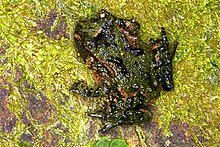
Back Environnement naturel en Nouvelle-Zélande French Биоразновидност на Нов Зеланд Macedonian Kepelbagaian bio di New Zealand Malay Biotska raznovrstnost Nove Zelandije Slovenian
| Part of a series on |
| Biota of New Zealand |
|---|
 |

The biodiversity of New Zealand, a large island country located in the south-western Pacific Ocean, is varied and distinctive. The species of New Zealand accumulated over many millions of years as lineages evolved in the local circumstances. New Zealand's pre-human biodiversity exhibited high levels of species endemism, but has experienced episodes of biological turnover. Global extinction approximately 65 Ma (million years ago) resulted in the loss of fauna such as non-avian dinosaurs, pterosaurs and marine reptiles e.g. mosasaurs, elasmosaurs and plesiosaurs.[1] The ancient fauna is not well known, but at least one species of terrestrial mammal existed in New Zealand around 19 Ma. For at least several million years before the arrival of human and commensal species, the islands had no terrestrial mammals except for bats and seals, the main component of the terrestrial fauna being insects and birds. As recently as the 14th century a component has been introduced by humans, including many terrestrial mammals.
New Zealand has developed a national Biodiversity Action Plan to address conservation of considerable numbers of threatened flora and fauna within New Zealand.
- ^ Campbell, Hamish; Gerard Hutching (2007). In Search of Ancient New Zealand. North Shore, New Zealand: Penguin Books. p. 121. ISBN 978-0-14-302088-2.
© MMXXIII Rich X Search. We shall prevail. All rights reserved. Rich X Search